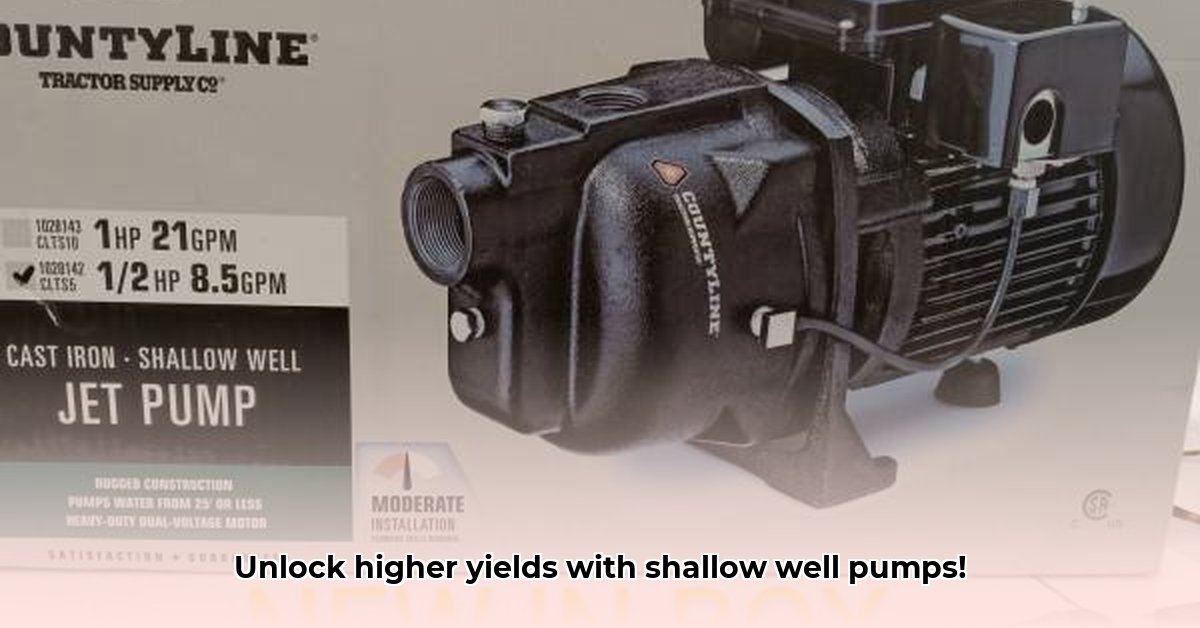
Getting reliable water to your crops and home is crucial for success, whether you're a farmer or homeowner. Shallow well pumps offer a practical and often affordable solution, but choosing the right one requires careful planning. This guide helps you select, install, and maintain a shallow well pump from Tractor Supply, maximizing efficiency and promoting sustainable water usage.
Choosing the Right Pump: A Personalized Approach
Selecting the right shallow well pump involves understanding your well's capabilities and your water needs. Let's break down the process:
1. Assessing Your Well's Capacity:
Determining your well's depth is straightforward using a measuring tape. However, measuring its yield (the amount of water it can produce) might require a professional well test. This is critical; an underpowered pump will struggle and overheat, while an overpowered pump is wasteful. Don't skimp on this step—it's an investment in long-term efficiency.
2. Calculating Your Water Needs (GPM):
Estimate your total gallons-per-minute (GPM) needs by adding up water usage for irrigation, household needs, livestock, etc. Always add extra capacity to account for future growth or unexpected demand peaks. Accurate calculation is key to selecting a suitably sized pump. Underestimating your needs can lead to insufficient water supply, impacting your yield.
3. Understanding Pump Types:
Tractor Supply offers jet and submersible pumps. Each has advantages and disadvantages:
Jet Pumps: These are generally less expensive and easier to install, making them ideal for DIY projects. However, they can be noisier and less energy-efficient than submersible options.
Submersible Pumps: These are quieter, more energy-efficient, and have longer lifespans. However, they're pricier and require more complex installation. The best choice depends on your well's depth, your budget, and your DIY skills.
4. Prioritizing Energy Efficiency:
Energy-efficient pumps may have a higher upfront cost, but they offer substantial long-term savings on your electricity bill. Look for pumps with high-efficiency motors and consider models with variable frequency drives (VFDs) that adjust pump speed based on demand, further optimizing energy use. A more energy-efficient pump is a more cost-effective pump in the long run.
5. Tractor Supply's Offerings:
Tractor Supply offers a variety of shallow well pumps with varying GPM ratings, horsepower, and energy efficiency. Compare models carefully, paying attention to reviews and specifications before making a purchase. Their knowledgeable staff can advise you based on your specific needs and local conditions. Don't hesitate to discuss your project with them; their expertise is a valuable asset.
Installing and Maintaining Your Pump: A Step-by-Step Guide
Correct installation is vital for pump performance and lifespan. While professional installation is often recommended, many find this a manageable DIY project. Follow these steps:
- Preparation: Gather tools, materials, and review manufacturer instructions. Familiarize yourself with your pump's specifications.
- Connection: Connect the pump to the well and plumbing, ensuring secure and leak-free connections. Pay close attention to seals and connections; leaks are a common problem.
- Priming: Prime the pump according to instructions; this is critical to prevent damage. Failure to prime properly can lead to pump failure.
- Testing: After installation, run the pump, checking for leaks or unusual sounds. Address any problems promptly.
- Maintenance: Regular maintenance is essential. Periodically flush the system to remove sediment and debris and visually inspect for wear and tear. Early detection of issues prevents major problems.
Sustainable Water Usage: Responsible Water Management
Conserving water is environmentally responsible and economically sound. Consider these practices:
- Efficient Irrigation: Drip irrigation delivers water directly to plant roots, minimizing evaporation and waste.
- Rainwater Harvesting: Collect rainwater for supplemental irrigation to reduce well water usage and conserve groundwater resources.
- Regular Well Monitoring: Monitor your well's water level regularly to detect potential depletion and adjust water usage accordingly.
Overuse can deplete aquifers; sustainable practices protect our shared water resources.
Troubleshooting and Resources: Addressing Potential Issues
If your pump malfunctions, consult the manufacturer’s troubleshooting guide first. Contact Tractor Supply's customer service or a local well specialist for assistance if needed. Don't delay addressing issues; early intervention prevents major problems and extends your pump's lifespan. Remember, a well-maintained pump is a more productive pump.
Key Takeaways:
- Understanding your well's capacity and your water needs is paramount for successful pump selection.
- Energy-efficient pumps provide significant long-term cost and environmental benefits.
- Proper installation and regular maintenance are essential for optimal pump performance and longevity.
- Sustainable water practices are crucial for responsible water management.
- Tractor Supply offers resources and expertise to guide your pump selection and maintenance.